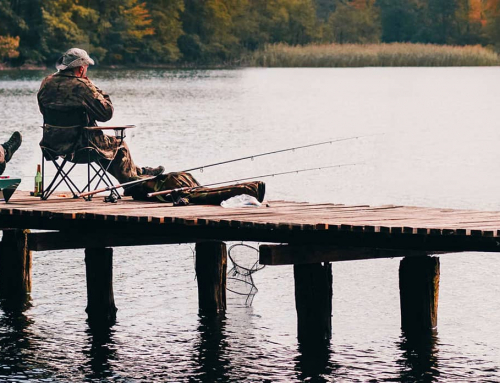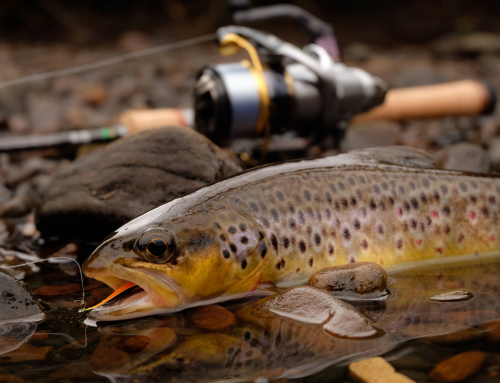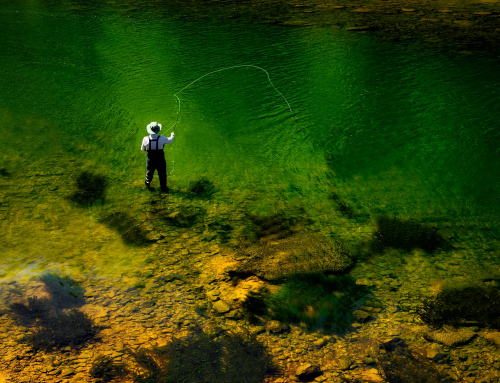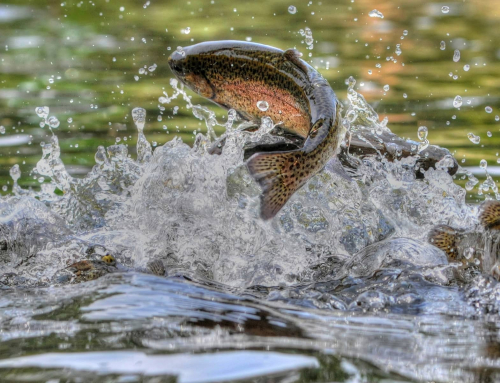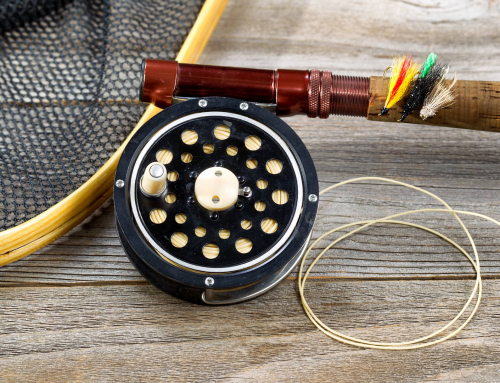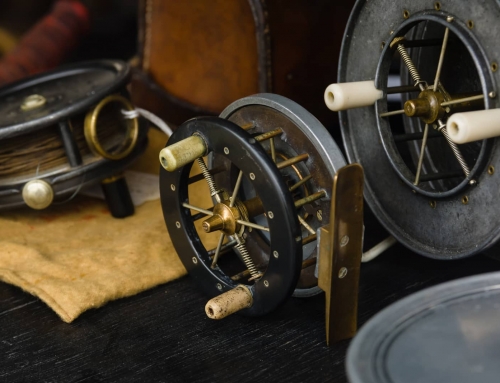We may earn money or products from the companies mentioned in this post at no additional cost to you.
How To Tell What Trout Are Feeding On
Do you love to fish for trout but never seem to catch any? Do you find that your lures and baits don’t quite hit the mark when targeting these elusive creatures? If so, then understanding what type of food sources they feed on is essential to increase your chances of success. In this article, we’ll explore how to tell what kind of prey trout are actively foraging at different times throughout the year. With some simple observation techniques, even novice anglers can learn how to spot signs that will help them land more fish!
Trout fishing doesn’t have to be a game of guesswork – there are actually many clues all around us that can give us an insight into their behavior and dietary preferences. By paying attention to our surroundings and learning what types of food sources are available, we can begin to unravel the mystery surrounding one of nature’s most elusive species. From insect hatches to changes in water temperature, certain environmental factors often dictate which kinds of bait or lure will work best for catching trout.
With a bit of patience and practice, anyone can become an expert fisherman capable of reading the waters like a book! So if you want to know exactly how to tell what trout are feeding on and use it as part of your fishing strategy, keep reading – because, by the end of this article, you’ll be well-versed in identifying key indicators that could lead you straight towards a successful day out on the riverbank!
Identifying Trout Food Sources
Figuring out what trout are feeding on could be the key to a successful fishing outing. With the right knowledge, you can take your angling game to the next level! So let’s explore what it takes to identify trout food sources.
The first step in identifying trout food sources is observing their behavior when they’re actively eating. Trout tend to go for small, fast-moving prey like insects and shrimp, so watch for quick movements near or at the surface of the water that indicate an insect hatch or school of baitfish. If you see these signs, there’s something good around for them to eat. Additionally, if you look closely enough into the water, you might even spot some of those tasty critters swimming about – making them easy targets for hungry trout!
Another way to determine what trout are likely feeding on is by studying their habitat. Different types of aquatic vegetation provide various types of nourishment, which will attract certain species of fish. Look around at what kind of plants are in the area; if they include weeds, algae, and other submerged plant life, then it’s likely that smaller organisms such as zooplankton will be present too—which means more food options for any nearby fish. Knowing this information gives us valuable insight into how we may want to target our quarry with specific lures or baits that imitate natural prey items found within their environment.
Armed with this knowledge, you now have a greater understanding of what kinds of foods drive your favorite fish species and where they’re most likely located during particular seasons or times of day – allowing you to make better decisions when selecting tackle and techniques while on the hunt!
Assessing The Appearance Of Trout
Assessing the appearance of trout can help you figure out what they’re feeding on. Of course, it’s not foolproof, but by paying attention to their physical characteristics and behavior, you can get a better idea of the type of food they are targeting.
When looking at a trout, take note of its coloring. Are there any bright orange spots? That could indicate it is eating insects and larvae from underneath rocks. If so, this means it is likely consuming other aquatic invertebrates as well, like caddisflies or mayfly nymphs. On the other hand, if the trout has more subtle colors, such as darker greens and browns, it might chase after small baitfish like minnows or sculpins in open water.
In addition to coloration, look for signs of distress in the fish. Trout that have been actively feeding will often show signs of stress when hooked – they’ll jump around trying to escape or thrash about wildly on your line. This indicates they were surprised while hunting prey and could not catch their meal before being disturbed! By taking all these factors into account when you spot a trout in the wild, you may gain some insight into what kind of food sources it is focused on catching. With practice and patience, you’ll soon become an expert fisherperson who knows exactly how to identify what meals attract the local trout population!
Examining Trout Feeding Areas
Want to know what trout are chowing down on? Examining their feeding areas is a great place to start. However, you’ll need to observe both the environment and the fish themselves in order to get an accurate picture of what’s happening. Let’s dive into how this works!
When analyzing where trout feed, you want to look for signs that they’re actively eating. The size of the waterway can offer clues – if it’s large enough, chances are there’s food available. Pay attention to current speed and depth; these factors impact how much oxygen is present in the area, affecting whether certain prey species will stick around. Similarly, the clarity of the water can help indicate what types of organisms live there. All of these elements work together to determine what food sources are available for trout, so be sure to take note!
Finally, closely observing individual trout as they swim around can give insight into their behavior and diet. See if you can spot them chasing after insects or smaller fish; this usually means they’ve found something good! Also, examine any remains they may have left behind from recent meals; this could hint at larger trends about what type of food they prefer most often. In all cases, keep your eyes peeled, and don’t be afraid to ask questions – with some patience and practice, you’ll soon become an expert at understanding just what those hungry little trouties are looking for!
Understanding Trout Behavior
Understanding trout behavior can be an invaluable tool for tracking down which type of food they are feeding on. It’s important to take the time to observe their behavior; this may sound like a lot of effort, but in reality, it is pretty simple.
When fishing for trout, look closely at how they act and react around different types of lures or baits. If you see that certain ones attract them more than others, then chances are good that those particular items make up part of their diet. Pay attention to whether they respond differently during various times of day as well — some species will feed heavily at dawn and dusk, while others might prefer midday meals.
Once you have identified the habits and preferences of your prey, use these clues to inform your decisions about what bait or lure should be used next time out.
Analyzing Water Quality
Trout behavior can give you much insight into what they’re feeding on, but analyzing the water quality is another way to understand their food sources. If you want an in-depth look at what’s going on underwater, it pays off to take a closer look at the environment around them.
The components of water chemistry are important when determining what type of food trout will be attracted to and feed on. Things like temperature and ph levels have a big impact on how much dissolved oxygen there is in the water and what types of organisms live there that could potentially become food for the fish. Additionally, factors such as turbidity or suspended particulates can also influence which foods are available for trout.
Understanding these elements helps you determine whether your local waters provide enough resources for trout populations to thrive and survive – essential if you hope to catch some yourself! By monitoring and adjusting these variables, anglers can create favorable conditions that increase the chance of successfully locating and catching their quarry.
Exploring The Bottom Of Trout Habitats
Exploring the bottom of trout habitats can give us valuable insight into what they are feeding on. A closer look at the environment these fish inhabit is vital to understanding their diet preferences and behaviors.
The nature of trout habitats means we must dive deeper than most anglers may be comfortable with. There’s no need to worry, as we don’t have to go too far down before discovering clues about the food they’re after. By examining aquatic plants and other organic matter around them, we can understand what kind of prey the trout might find attractive. It’s also possible to look for signs of insect larvae or small crustaceans to determine which food sources are available in the water column.
By studying this underwater world, you’ll get an accurate picture of how Trout feed and where they’re likely to search for food so you can better prepare for your next fishing trip! In addition, knowing what kind of bait will best attract these creatures gives you a leg up when it comes time to cast out lines.
Investigating Plant Life In Trout Areas
Investigating plant life in trout areas can help reveal what the fish are feeding on. To do this effectively, it’s essential to understand a few key points about their habitat and behavior. This will provide greater insight into their diets and allow us to observe these majestic creatures up close while they go about their natural routines.
Trout generally inhabit shallow waters with plenty of vegetation and slow-moving currents. These conditions make for ideal places to search for the types of plants that form part of these aquatic animals’ diets:
Duckweed
Water lilies
Algae
Mosses
Chara weed
By studying the environment around them, we’re better able to recognize signs of recently disturbed water or evidence of riverbed activity from fish searching out food sources. This approach is handy when determining which species live within a particular body of water and how active they are during certain times of day. Additionally, understanding what type of vegetation grows natively near rivers and streams gives us crucial insight into knowing which kinds might be more likely favored by trout and other aquatic wildlife.
In short, recognizing the flora that thrives in trout habitats provides valuable information on what they feed upon naturally – giving us all a clearer picture of their fascinating world beneath the surface!
Examining Insect Life In Trout Areas
When it comes to understanding what trout are feeding on, examining the insect life in their environment is essential. By taking a closer look at the aquatic insects living near trout areas, you can better understand what these fish might be eating.
Insects make up much of the diet for many types of trout; various species feed on flies and larvae in nearby creeks and rivers. So to answer our original question – how do we tell what trout are feeding on? – looking into the insect life around them is key.
We must pay attention to which insects are present in a given area and when they’re most active and abundant. Knowing this information will give us insight into the seasonal habits of local trout populations – all without ever having to hook one! In addition, with some research about the insect life around your favorite fishing spot, you’ll have greater success knowing which lures or bait you should use next time out.
Noting The Presence Of Fish Eggs
Noting the presence of fish eggs is a great way to identify what trout are feeding on. Fish eggs offer a high nutrient content that can be difficult for trout to resist! By looking closely at the water and identifying any egg masses, you can quickly gain insight into what your target species may be feasting on.
When searching for fish eggs, it’s important to look in areas where there may be more aquatic insects than others. These spots are often near grassy banks or around rocks and other structures that provide shelter and protection from predators. Additionally, these locations typically contain higher concentrations of food sources like aquatic insects, which produce eggs as part of their lifecycle.
So if you’re interested in learning what type of food trout may be consuming, keep an eye out for signs of fish eggs! With some practice and patience, you should start seeing patterns emerge, which will give you valuable insights into the diets of local trout populations. This knowledge can help inform anglers when targeting specific types of prey, ultimately resulting in better fishing success!
Watching Trout Feeding Patterns
Do you want to know how to determine what trout are feeding on? Watching their feeding patterns can provide valuable insight. With a keen eye and some patience, you may even be able to spot clues as to the type of food they’re feasting on.
Observing trout carefully is key, especially when they’re actively hunting for prey. You should pay attention to the shape of their bodies as they move through the water and try to identify any telltale signs that suggest which kind of food they’ve got their sights set on. For example, if you see them darting quickly in short bursts, then it could indicate that insects or small fish have been spotted nearby.
The best way to get an idea of what trout are eating is by looking at their stomach contents after catching one – but this isn’t always easy! If you do manage to take a look inside its belly, you’ll likely find eggs from other species, like salmon or crayfish – giving you a better indication of what’s really going down beneath the surface. It might not always be possible, but with patience and practice, it can help give you a greater understanding of these mysterious creatures’ diets.
Utilizing Trout Tracking Technology
Tracking technology is the way to go if you’re looking to get an edge on your trout fishing. By utilizing cutting-edge tools like sonar and cameras, anglers can gain valuable insight into what’s going on below the surface. This knowledge makes it easier to identify what food sources the fish are hitting and how they’re behaving in their environment – giving you a better chance at hooking up with these wily creatures.
With this tech, you don’t have to rely on watching the feeding patterns of nearby trout. Instead, you’ll be able to observe things such as depth changes, water temperature, oxygen levels, and more – all from one spot! No longer will you need to guess what may or may not work when trying to land that big one; now, you’ve got access to real-time data that offers greater accuracy for predicting where the best catches are likely located.
Access to accurate information about where those prized bites are happening gives fishermen a sense of freedom – allowing them to explore new areas without having to worry about missing out on any opportunities. And all it takes is a few clicks of a button! So if you want an advantage when it comes time for Trout season, consider investing in some reliable tracking tech. It could make all the difference.
Learning About Trout Migration Patterns
Are you curious about trout migration patterns? It’s an important part of understanding what they’re feeding on. With the right tools, we can gain insight into their behaviors and habits!
Tracking technology has revolutionized our ability to monitor these elusive fish. We can now identify where they go throughout the year – from shallow streams in springtime to deep lakes during summer months. This knowledge helps us understand how to best provide for them so that populations remain healthy and abundant.
By learning about their migratory paths, we can get one step closer to answering the question of what trout are eating. Through this research, we unlock a world of information that will help protect these amazing creatures for generations to come. Who knows – maybe someday soon, every angler will be able to accurately predict when and where fish will feed!
Understanding Trout Food Preference
Have you ever wondered what trout are feeding on? Understanding their food preference is key to unlocking the mysteries of these majestic creatures.
It’s not enough to observe a school of trout, as they could be migrating or just passing through an area and may have different dietary habits depending on where they’re heading. To truly understand trout’s food preferences, we must look at their behavior when it comes to foraging.
Trout usually feed in shallow streams during dawn and dusk, when insects and other prey items are more abundant. They can also be seen actively searching for food among vegetation or snatching up small fish from the water column. By observing these patterns of activity, anglers can get an idea of what kind of food the trout prefer in any given area and better plan their fishing trips accordingly.
Knowing what type of foods appeal most to trout lets us gain insight into their natural environment so we can enjoy catching them while respecting their habitat and ensuring healthy populations for generations to come.
Determining The Best Time To Fish For Trout
When it comes to trout fishing, timing is key. Knowing when and where the fish are most likely to feed can give you an edge over other anglers. So how do you determine the best time to cast your line for a successful catch?
The answer lies in understanding the behavior of trout and their environment. Different times of day offer different conditions that attract trout. During dawn or dusk, they tend to come out in search of food in shallow waters with plentiful vegetation and insects near the surface. In contrast, at midday, they often move into deeper areas away from direct sunlight. Additionally, during spawning season (usually spring through summer), look for clear pools in rivers and streams where female trout lay their eggs – this is prime feeding grounds!
To make sure you don’t miss any opportunities while on the water, keep track of local weather reports as well as seasonal patterns. Cold fronts usually drive more trout toward shorelines, so if you know there’s one coming, plan accordingly! Also, be aware of high-pressure systems which generally suppress activity among these pesky predators – not ideal for catching them! Take all these factors into account when planning your next outing, and you’ll have better luck finding those elusive wild trout!
FAQ
TIP: Always check with local guides before heading out on your next fishing trip – they can provide invaluable insight into the specific type of environment needed for successful trout catches!
Final Thoughts on Trout Feeding
The best way to tell what trout are feeding on is by understanding their behavior and environment. With knowledge of the type of bait, depth at which to fish, environmental conditions, and the ideal times of day for fishing, you’ll be sure to increase your chances of success when targeting these species.
It’s important to remember that different types of trout might require varying approaches; however, some general rules will help regardless. For example, always use smaller lures or live bait in clear water with a slow retrieve. This usually works fine for all kinds of trout. In addition, it’s important to pay attention not only to the weather but also to the temperature and clarity of the water before beginning any fishing trip.
Ultimately, paying close attention to these details can help maximize your potential when trying to figure out what kind of food trout are eating! If you keep this information in mind during your next outing, you should have plenty of luck catching some nice-sized trout!
Stay tuned for our upcoming destinations Feature: Owens River, California! Or, check out our blog on The 7 Best Drones for Fishing.
